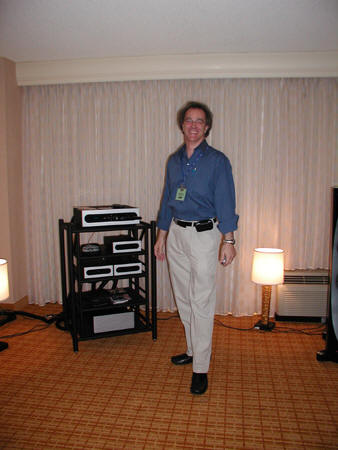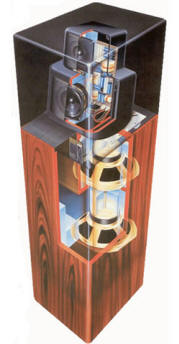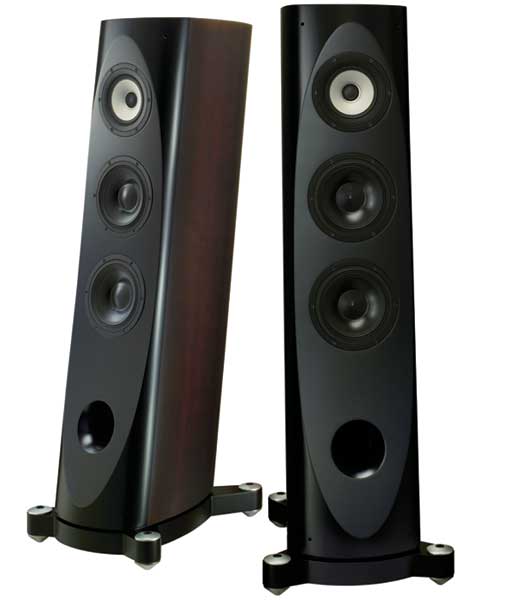|
You are reading the older HTML site Positive Feedback ISSUE march/april 2007
An Interview with Andrew Jones of Pioneer
Dave Clark So what is your background? Andrew Jones A life long interest in hi-fi from very early teens. Born in stereo (I have an identical twin brother, he is left handed I am right handed—a stereo pair!) I studied Physics and acoustics at university in England, followed with three years postgraduate research in computer aided x-over network design and then three years research in active noise control. DC So how did you get into speaker design? AJ I was sponsored in my post grad work by Celestion, and I knew Laurie Fincham of KEF from attending Audio Engineering Society lectures and from Hi-Fi shows. One day almost out of the blue Laurie he offered me a job at KEF, initially in the research department. In time I became Chief Engineer. KEF in those days had the most advanced R&D in the UK.
DC Who have you worked with and on what products? AJ With regard to the people I have worked with, I have been fortunate to have worked with and known some of the great minds of our industry. Laurie Fincham of course, Raymond Cooke, Dr Richard Small, Neville Thiele, Peter Walker, Peter Baxandal, Stan Lipshitz, John Vanderkooy, Siegfried Linkwitz, Floyd Toole, and numerous others.
As for the companies, I started in this industry
with KEF, then moved across the pond to join Infinity,
Products that I have contributed to or been responsible for include KEF 107/2, many of the UNI-Q reference line of speakers, the KEF K-UBE electronics, Infinity Prelude, Overture and Reference Series speakers, Pioneer TZ700 series, and now the TAD and EX speakers. DC How did this shape your design philosophy or approach in designing speakers for today? AJ First, my time at KEF taught me a great deal about engineering not just speaker systems, but the drivers themselves. At that time we made all our own drivers, so we built all the prototypes ourselves. We also pioneered new measurement techniques, spending around $100k for our first HP Fourier analyzer back in the late 70s, a fortune. We also did a lot of work in computer aided network design and cabinet vibration isolation techniques. Then of course came the work with the UNI-Q. These factors have stayed with me in various forms. The discipline of good measurements correlated properly to listening, no fear of complex x-overs when necessary, and the proper control of driver directivity and off axis response. DC How did you end up at Pioneer? AJ In '97 Pioneer built a new state of the art speaker design facility to carry out design for the USA market. I was invited to head up the design group. It was a dream position for an engineer like myself. Great facilities and access to advanced engineering capabilities in Japan. DC What was the goal? AJ From a clean sheet of paper, design new types of speaker to show what Pioneer are capable of and advance the science of speakers.
DC Can you explain the design objectives and how you met them with the EX series and Pioneer?
DC Why this and not that? (crossover, bi-wire, cabinet, woofers, etc) AJ As with the Model 1, principle features include a concentric driver for directivity control and point source radiation, advanced cone materials (Beryllium, Magnesium, woven aramid and carbon fibre for the bass drivers and advanced cabinet construction. Every driver is custom designed and manufactured by Pioneer. No off-the-shelf drivers.
DC Why Beryllium as opposed to diamond for the tweeter? AJ We have been making beryllium diaphragms for over thirty years now, using the technique of vapour deposition. We have built up an enormous body of knowledge with regard to manufacturing consistency and quality. We chose beryllium originally for its unparalleled stiffness to mass ratio, necessary to move cone resonances up as high as possible. The only comparable material is diamond, but its density is almost twice that of beryllium and so its use leads to a increase in moving mass and hence reduced sensitivity, a trade off we didn't want to make in these new products. We have in the past though manufactured diamond tweeters. Around 10 years ago these were actually on sale in Pioneer speakers in the Japanese market. So both beryllium and diamond are not new materials in speakers!! DC Series crossovers were all the rage a while ago, what are your thoughts on crossovers in general—advantages, disadvantages? Bi-wire, single? AJ I have misgivings about series x-overs. Some proponents of these mis-understand the fundamentals of x-over and driver integration and assume properties that don't exist in practice. Furthermore series networks have strong interactions between sections that make manufacturing a consistent product much more difficult. Finally they have the potential for the distorted current flow of the drivers to flow through each other, not a very desirable interaction. My preference is to stay with parallel networks. DC What about audiophile type parts? Any advantage? Wire, caps, etc. AJ We have high quality parts certainly, mostly manufactured by ourselves or to our specification. If you mean name brands of audiophile parts, then no. We do not put in such parts as a means for listeners to think "Oh, it contains brand X capacitors, it must be good" for example. We select our parts based on engineering, not marketing.
DC So then, is it all about engineering? AJ YES! DC What role is listening involved in with respect to the design/measurements …or does the actual design/measurements take precedent over what you hear… that is, if I can hear it, who cares how it measures? AJ First comes the measurement. There are a lot of parameters in speakers that can be measured that are known to correlate well with listening. The problem that I see so often from those who doubt such correlation exists is that they don't know how to measure accurately! I see their curves and I see the artifacts in the curves that are the result of measurement errors and nothing to do with the behaviour of the speaker itself! Accurate measurements and a sufficient set of measurements go a long way to revealing the performance, and allow us to get towards the final result very much quicker than with just listening alone. My approach is to set a design goal for the measured performance, meet this as close as possible, then evaluate the result by listening, but ONLY once I believe I have met the initial design objective. Then I try and honestly evaluate the result, and if (when……) I hear something wrong I go back and see if I can correlate this to the measurements. Maybe I was too enthusiastic in my evaluation of having met my target. Maybe my target is just wrong. I go back and make changes based on the re-evaluation, then re-listen. But I am always cross referring to the measurements. DC What shortcomings or limitations are there as to what one can measure versus what can hear? AJ I am not implying that we can measure everything that we hear. But we can measure a lot so we can shorten the design process. We can also however hear a lot of what isn't actually there! We can be easily misled in our hearing evaluation and attribute things that don't really exist. With too many variables during the design process we can also become confused. So we have to be as careful in our listening as we have to be in our measuring. DC What speakers from other manufactures do you admire? AJ I have many products that I admire. These range from those that I like the sound of, to those that I admire the engineering of but don't like the sound! To those that employ fascinating technologies. I particularly like Quad electrostatics, having been a fan since my very first exposure to 'real” hi-fi which was a system comprised of Quad 33/303 and ESL57 speakers. I still own a wide selection of various implementations of electrostatics, though Peter Walker for me was the one who most advanced the science of such speakers.
DC What is the next step for you and Pioneer? AJ You want me to give away my game plan in print?
|


 then on to Pioneer and
TAD.
then on to Pioneer and
TAD.  AJ Well the EX speakers are derived from the TAD
Model 1 project. This was a state of the art assault on the high end speaker
market, to combine all that we knew from all of our engineering groups and to
morph TAD from being Pro only into Home audio as well. This was a fascinating
project to work on and very successful. However the Model 1 was very expensive
($45,000/pr). The EX series is our attempt to offer much of what we have in the
Model 1 but at a more affordable price.
AJ Well the EX speakers are derived from the TAD
Model 1 project. This was a state of the art assault on the high end speaker
market, to combine all that we knew from all of our engineering groups and to
morph TAD from being Pro only into Home audio as well. This was a fascinating
project to work on and very successful. However the Model 1 was very expensive
($45,000/pr). The EX series is our attempt to offer much of what we have in the
Model 1 but at a more affordable price.